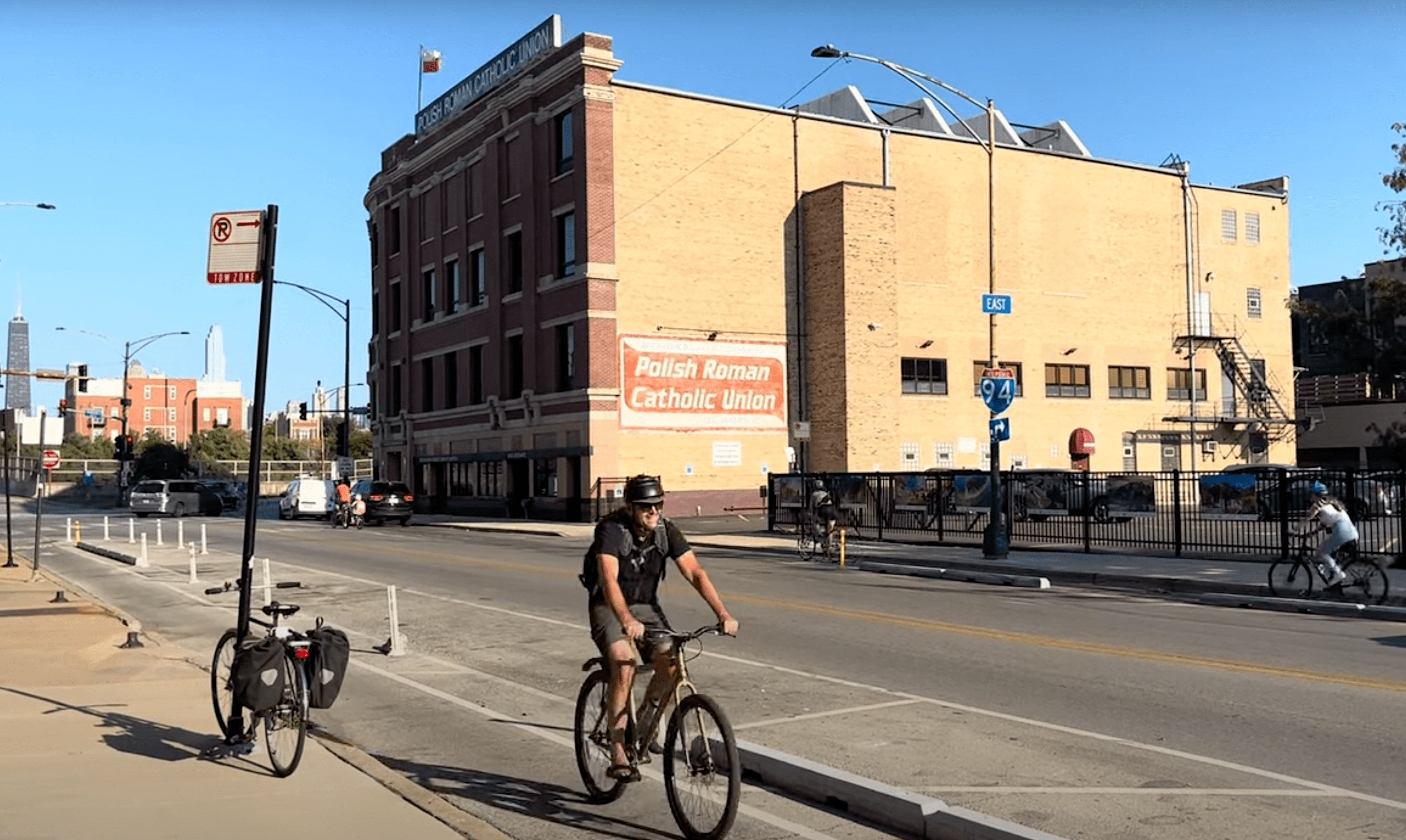
In my decade-plus of running this site, my interactions with real estate professional and West Town resident A. J. Manaseer have surely been the most civil ones I've have with a Chicago bike route skeptic.
(For an example of a recent, less-than-cordial cordial, exchange with another bikeway questioner, check out the update on this article about Lakeview's Dickens Greenway.)
Granted, I wasn't a fan of Manaseer's language in an August 8 tweet in which he challenged local sustainable transportation advocates to prove that the Augusta Boulevard protected lanes aren't an "an underutilized white elephant."
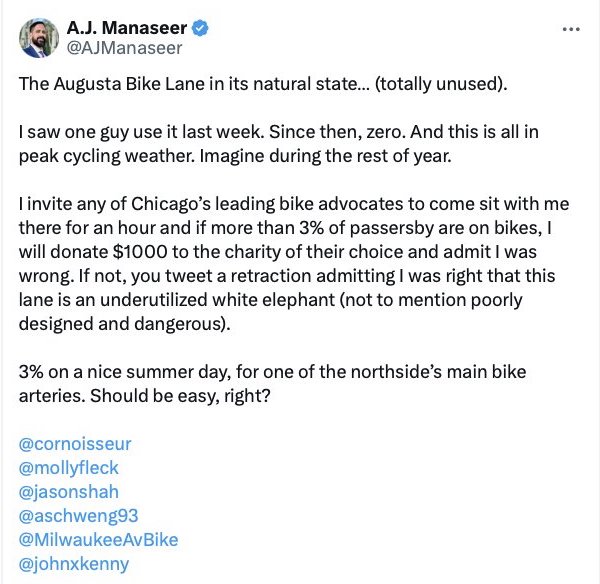
But when I took Manaseer up on his offer, the negotiation that followed on- and offline were fairly polite. We eventually agreed on the following rules, explained at length in the documents attached to my tweet below.
It’s on! @AJManaseer and I will meet in the near future to count the percentage of vehicle operators on Augusta Boulevard just west of Milwaukee Avenue who are using sustainable transportation devices. Manaseer’s original tweets, and the rules we recently agreed on, are attached. pic.twitter.com/fuBTUL9ByP
— John Greenfield (@greenfieldjohn) September 8, 2024
In brief, we decided that if less than 3 percent of vehicle operators we counted in an hour on the block of August west of Milwaukee Avenue were using sustainable transportation devices (bikes, scooters, etc.), he would win. And if 3 percent or more vehicle operators were using these devices (whether solely human-powered or electric), I would win. Ultimately, I chose to take the high road and not count any cyclists, scooteristas, etc. who weren't using the protected lanes, or were riding the wrong way.
Another rule we agreed on, based on Manaseer's follow-up tweet to his original post, was that Manaseer got to pick the date and time. He chose Monday, September 9, from 3:30 to 4:30 p.m. It was about 80 F, fine weather for biking, I'd say.
As I discussed in my summary of the experiment the next day, the encounter was completely amicable. Manaseer even offered me some cold drinking water after I pedaled five miles to our meet-up spot from Uptown.
The full video of our count on Monday 9/9/24 from 3:30 to 4:30 p.m.
We ultimately agreed that we counted 688 non-sustainable transportation device operators (car, truck, motorcycle, etc.), and 33 bike or scooter users who had been riding in the protected lanes as intended. So that was roughly 4.80 percent of the total traffic flow, or about 60 percent higher than the required 3 percent.
Manaseer was generally a good sport about the outcome. He admitted at the end of the above video, and in a subsequent tweet that "I have lost this bet."
He was also more than honorable about following through with his offer to donate $1,000 dollars to charity if he was defeated. On my suggestion, he earned extra credit by giving $250 each to five local nonprofits that run bike education programs: Blackstone Bicycle Works, Equiticity, The Recyclery, West Town Bikes, and Working Bikes. So, in effect, he gave 125 percent. I spread the good news via the Streetsblog Chicago Twitter account and declared the bet completed.
SBC disproved @AJManaseer's claim that the Augusta protected bikeway "is an underutilized white elephant." But we can't question his generosity to local bike ed programs (or taste in "Peanuts" stamps.) This wager is now successfully concluded. 🚲🛴💰👍https://t.co/nRZkzWYn11 pic.twitter.com/1k3F2DHZfc
— Streetsblog Chicago (@streetsblogchi) September 23, 2024
Now that that's out of the way, and with no disrespect intended to Manaseer, whom again I think generally behaved honorably here, I'd like to discuss some of the comments he tweeted out on the day after our September 9 count. Read the whole thing in the tweet below.
So to begin with I'd like to thank John for making the effort to meet me and follow through on this little experiment. It's always good to meet and have a civil conversation with people of differing views and it was a fun experience.
— A.J. Manaseer (@AJManaseer) September 11, 2024
𝗔𝗹𝗹 𝗶𝗻 𝗮𝗹𝗹, 𝗷𝘂𝘀𝘁 𝘂𝗻𝗱𝗲𝗿 𝟱%… https://t.co/TMzm6u47Kz
I certainly agree with the first paragraph. The counting session with Manaseer was an enjoyable activity, and it made me rethink my occasional "take-no-prisoners" approach to debunking bikeway opponents.
Next Manaseer wrote, "All in all, just under 5 percent (4.8 percent) of vehicles were bikes/scooters. So while I have lost this bet, I feel validated for the following reasons." See a couple of them below:
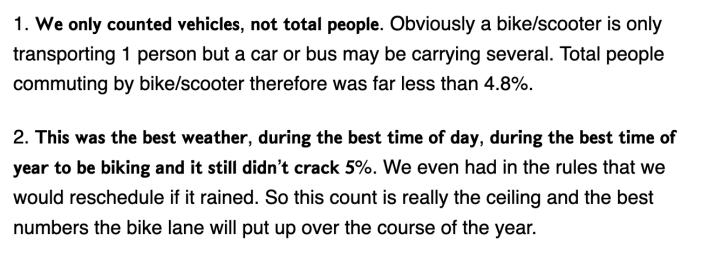
"Overall my skepticism of the usefulness of this bike lane is reinforced," Manaseer wrote. "And now when bike lane advocates make claims about predicted usage we all have some frame of reference, so that’s useful for everyone."
Therefore Manaseer admitted that Streetsblog proved him wrong, blowing his less-than-three-percent prediction out of the water by roughly 60 percent. But he still claimed that the 4.8 percent count reenforced his belief that the August PBLs are useless?
Let's unpack a couple of Manaseer's statements. For starters, "Obviously a bike/scooter is only transporting one person but a car or bus may be carrying several." First of all, it's not uncommon for more than one person to ride the same bike or scooter, and some vehicles such as tandems bicycles, bikes with child seats, and cargo cycles, are designed for that purpose.
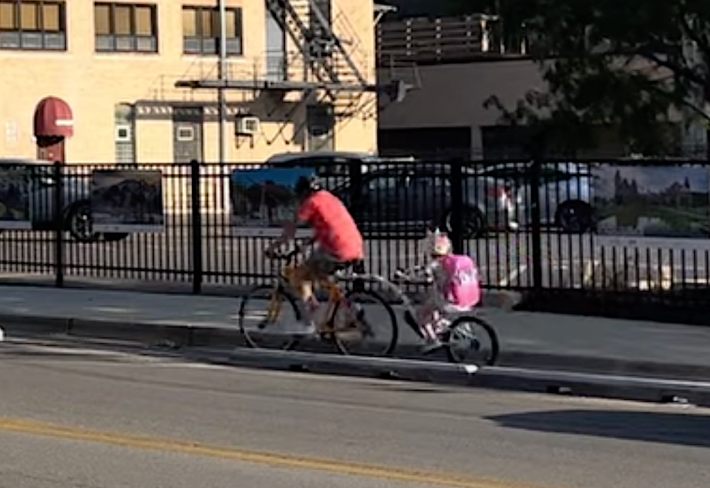
Moreover, there's no permanent CTA bus service on Augusta. And according to Census records, most Chicagoans who commute to and from work by car are driving solo. In addition, a single passenger being transported by a taxi or ride-hail driver doesn't count as two "people commuting." Therefore Manaseer's claim that the "total people commuting by bike/scooter... was far less than 4.8 percent" is almost certainly false.
And then there's Manaseer's statement that our sustainable transportation device operator count was done "during the best time of day... and it still didn't crack 5 percent." However, 3:30 to 4:30 p.m. on a weekday is not the best time of day to count bike and scooter commuters, since most people aren't leaving 9-to-5 jobs at that time.
Yesterday, I asked Manaseer on Twitter, "Despite losing, you said, 'I feel validated' the bikeway is an 'underutilized white elephant' because [the count] was 'only' 4.8 percent... So how high would the percent have to be for you to admit Augusta is not a UWE?"
"It’s tough to say from a little snapshot in time," Manaseer replied. "I would think if 5 percent of commuters yearlong traveled using the lane it would be justifiable."
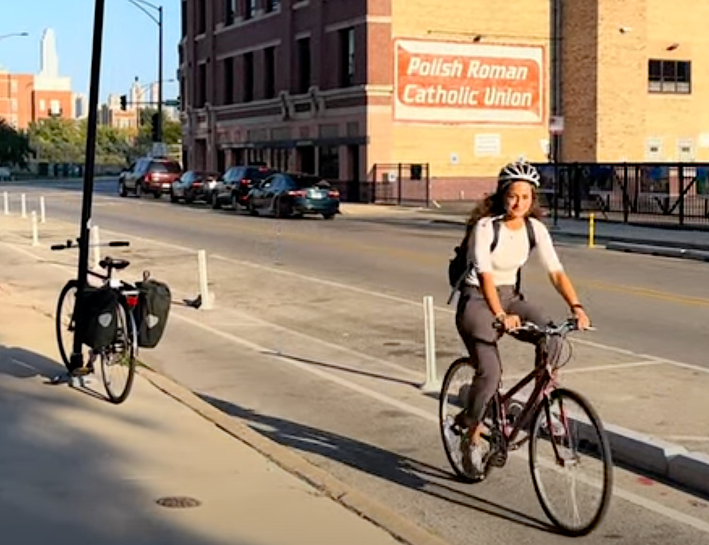
As it happens, I did another one-hour count about a week after our original session, on Tuesday, September 17, when the weather was also sunny and around 80 F. But this time I counted between 4:45 and 5:45 p.m., when I was more likely to see bike and scooter riders.
(I would have invited Manaseer to join me again, but he previously told me that, to his credit, he leaves his home on Augusta every weekday afternoon around 4:45 to pick up his kid. After our original bet was resolved, there were no longer rules of engagement to observe. But, as a courtesy, I shared this new article with him before publicizing it, in case he had any major issue with it. "Go ahead, no objection," he replied.)
I counted vehicle operators as they passed by me on Augusta. Like the previous video, I don't think the video below is the most fascinating thing in the world for Streetsblog readers to watch for an hour, at least if you're stone-cold sober. But you might find a few moments interesting or amusing.
The full video of my count on Tuesday 9/17/24 from 4:45 to 5:45 p.m.
Summary of results (After reviewing video):
Total number of non-sustainable transportation device operators (cars, trucks, vans, motorcycles etc.) who passed me: 731
Total number of sustainable transportation device operators who passed me (riding in a protected lane in the direction of traffic): 104
People operating bicycles (any kind, non-electric or electric, riding in protected lane with traffic): 86
People on electric scooters (riding in protected lane with traffic): 18
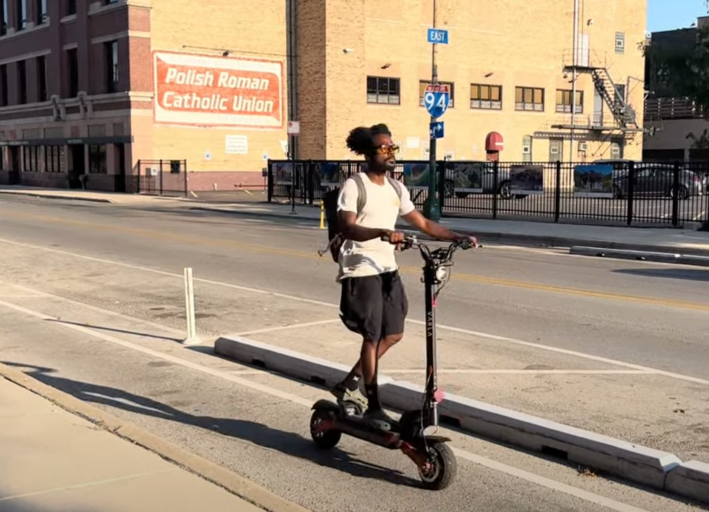
Conclusions
Let's not count the relatively small number of bike or scooter riders who weren't using the protected lanes, or were riding the wrong way in them. Assuming we do that, hey, I'm happy to count any motorists who weren't following the letter of the law either.
Therefore 104 out of 835 total vehicle operators on Augusta were using sustainable transportation devices as intended in the protected lanes. That comes to about 14.23 percent of vehicles operators. That's roughly three times the percentage we counted the previous week, under similar conditions, but "during the [actual] best time of day," as Manaseer would put it."
Again, Manaseer previously stated that "I would think if 5 percent of commuters yearlong traveled using the lane it would be justifiable." So perhaps nearly three times that percentage during peak times is enough to convince to him for good that the Augusta protected lanes aren't an "underutilized white elephant"?
I suppose it's possible Manaseer will simply move the goalpost again. But even if these numbers still aren't good enough for him, surely they speak for themselves.
In addition, Chicago should build a citywide, connected network of protected lanes, not just on streets where many people are currently biking or riding scooters, but so that more folks will feel safe using doing so in the future. After all, no one insists on seeing proof that lots of people are swimming across dangerous rivers, before they accept that it makes sense to build bridges!

Did you appreciate this post? Please consider making a tax-deductible donation, to help keep Streetsblog Chicago's sustainable transportation news and advocacy articles paywall-free.
